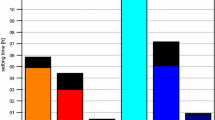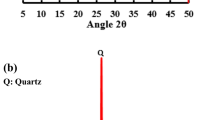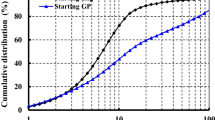Abstract
Alkali silicate activated slag (AAS) most commonly develops high strength, but is usually accompanied by fast setting. In this study, slag was activated by a potassium silicate solution possessing different moduli (Ms = 0.7 and 1). The workability of the alkali activated slag mortar, at 4 and 20 min, was assessed by means of a mini-slump test. The sample with an Ms of 1 was not workable after 20 min. Calcium formate was subsequently added to extend the workable time of the mortar but this lowered its compressive strength. Ultrasonic measurements indicated a slower solid phase development in the AAS paste, in the presence of calcium formate, which was associated with a decreased amount of C–S–H gel in the hydrates.








Similar content being viewed by others
References
Komljenović M (2015) Mechanical strength and Young’s modulus of alkali-activated cement-based binders. In: Pacheco-Torgal F (ed) Handbook of alkali-activated cements, mortars and concretes. Woodhead Publishing, Cambridge, pp 171–215
Tänzer R, Buchwald A, Stephan D (2015) Effect of slag chemistry on the hydration of alkali-activated blast-furnace slag. Mater Struct 48(3):629–641
Haha MB, Lothenbach B, Le Saout G, Winnefeld F (2011) Influence of slag chemistry on the hydration of alkali-activated blast-furnace slag—part I: effect of MgO. Cem Concr Res 41(9):955–963
Haha MB, Lothenbach B, Le Saout G, Winnefeld F (2012) Influence of slag chemistry on the hydration of alkali-activated blast-furnace slag—part II: effect of Al2O3. Cem Concr Res 42(1):74–83
Wang S-D, Scrivener KL, Pratt PL (1994) Factors affecting the strength of alkali-activated slag. Cem Concr Res 24(6):1033–1043
Krizan D, Zivanovic B (2002) Effects of dosage and modulus of water glass on early hydration of alkali–slag cements. Cem Concr Res 32(8):1181–1188
Dakhane A, Peng Z, Marzke R, Neithalath N (2014) Comparative analysis of the influence of sodium and potassium silicate solutions on the kinetics and products of slag activation. Adv Civ Eng Mater 3(1):371–387
Tänzer R, Jin Y, Stephan D (2017) Alkali activated slag binder: effect of cations from silicate activators. Mater Struct 50(1):1
Shi C, Krivenko PV, Roy DM (2006) Alkali-activated cements and concretes: theory and application. Taylor & Francis, London
Zhang Z, Zhou D, Li F, Pan Z, Yang N (2008) Selection of retarder of alkali activated slag cement. Concrete 8:63–68 (in Chinese)
Brough AR, Holloway M, Sykes J, Atkinson A (2000) Sodium silicate-based alkali-activated slag mortars. Part II. The retarding effect of additions of sodium chloride or malic acid. Cem Concr Res 30(9):1375–1379
Chang JJ, Yeih W, Hung CC (2005) Effects of gypsum and phosphoric acid on the properties of sodium silicate-based alkali-activated slag pastes. Cement Concr Compos 27(1):85–91
Gong C, Yang N (2000) Effect of phosphate on the hydration of alkali-activated red mud–slag cementitious material. Cem Concr Res 30(7):1013–1016
Kalina L, Bílek V, Novotný R, Mončeková M, Másilko J, Koplík J (2016) Effect of Na3PO4 on the hydration process of alkali-activated blast furnace slag. Materials 9:(5)
Schultze W (1995) Dispersions-Silikatsysteme: Grundlagen - Formulierungen - Problemlösungen. Expert-Verlag, Renningen-Malmsheim
Snellings R (2013) Solution-Controlled Dissolution of Supplementary Cementitious Material Glasses at pH 13: The Effect of Solution Composition on Glass Dissolution Rates. J Am Ceram Soc 96(8):2467–2475
Suraneni P, Palacios M, Flatt RJ (2016) New insights into the hydration of slag in alkaline media using a micro-reactor approach. Cem Concr Res 79:209–216
DIN EN 1015-3 (2007) Prüfverfahren für Mörtel für Mauerwerk – Teil 3: Bestimmung der Konsistenz von Frischmörtel (mit Ausbreittisch). 2004th ed; 91.100.10. Deutsches Institut für Normung e. V, Berlin, Germany
DIN EN 196-1 (2015) Prüfverfahren für Zement – Teil 1: Bestimmung der Festigkeit. 2015th ed; 91.100.10. Deutsches Institut für Normung e. V, Berlin, Germany
von Daake H, Stephan D (2016) Setting of cement with controlled superplasticizer addition monitored by ultrasonic measurements and calorimetry. Cement Concr Compos 66:24–37
Alonso MM, Gismera S, Blanco MT, Lanzón M, Puertas F (2017) Alkali-activated mortars: workability and rheological behaviour. Constr Build Mater 145:576–587
Fernández-Jiménez A, Puertas F (1997) Alkali-activated slag cements: kinetic studies. Cem Concr Res 27(3):359–368
Trtnik G, Turk G, Kavčič F, Bosiljkov VB (2008) Possibilities of using the ultrasonic wave transmission method to estimate initial setting time of cement paste. Cem Concr Res 38(11):1336–1342
Silverstein RM, Webster FX, Kiemle DJ (2005) Spectrometric identification of organic compounds, 7th edn. Wiley, Hoboken
Yu P, Kirkpatrick RJ, Poe B, McMillan PF, Cong X (1999) Structure of calcium silicate hydrate (C–S–H): near-, mid-, and far-infrared spectroscopy. J Am Ceram Soc 82(3):742–748
Fernandez-Jimenez A, Puertas F (2003) Effect of activator mix on the hydration and strength behaviour of alkali-activated slag cements. Adv Cem Res 15(3):129–136
Mohassab Y, Sohn HY (2015) Analysis of slag chemistry by FTIR-RAS and Raman spectroscopy: effect of water vapor content in H2–H2O–CO–CO2 mixtures relevant to a novel green ironmaking technology. Steel Res Int 86(7):740–752
Garbev K, Beuchle G, Schweike U, Merz D, Dregert O, Stemmermann P (2014) Preparation of a novel cementitious material from hydrothermally synthesized C–S–H phases. J Am Ceram Soc 97(7):2298–2307
Pang LSK, Vassallo AM, Phong-anant D, Wilson MA (1993) A study of slag in laboratory, pilot and commercial scale furnaces using FTIR microscopy, electron microscopy and NMR spectroscopy. Fuel Process Technol 33(1):13–32
Myers RJ, Bernal SA, San Nicolas R, Provis JL (2013) Generalized structural description of calcium-sodium aluminosilicate hydrate gels: the cross-linked substituted tobermorite model. Langmuir 29(17):5294–5306
Le Saoût G, Ben Haha M, Winnefeld F, Lothenbach B, Jantzen C (2011) Hydration degree of alkali-activated slags. A 29Si NMR study. J Am Ceram Soc 94(12):4541–4547
Zhang L, Glasser FP (2000) Critical examination of drying damage to cement pastes. Adv Cem Res 12(2):79–88
Gruskovnjak A, Lothenbach B, Holzer L, Figi R, Winnefeld F (2006) Hydration of alkali-activated slag: comparison with ordinary Portland cement. Adv Cem Res 18(3):119–128
Gruskovnjak A, Lothenbach B, Winnefeld F, Münch B, Figi R, Ko S-C et al (2011) Quantification of hydration phases in supersulfated cements: review and new approaches. Adv Cem Res 23(6):265–275
Mu J, Perlmutter DD (1981) Thermal decomposition of carbonates, carboxylates, oxalates, acetates, formates, and hydroxides. Thermochim Acta 49(2–3):207–218
Acknowledgements
The authors thank Dr. Ehrenberg (FEhS) and Dr. Krakehl (Woellner GmbH) for the supply of slag and alkali silicate solutions. Furthermore, the work of the laboratory staff of TU Berlin is greatly acknowledged.
Funding
This study was funded by Arbeitsgemeinschaft industrieller Forschungsvereinigungen (AiF, Grant Number: 18856 BG).
Author information
Authors and Affiliations
Corresponding author
Ethics declarations
Conflict of interest
We declare that there is no conflict of interest in this study.
Additional information
Publisher's Note
Springer Nature remains neutral with regard to jurisdictional claims in published maps and institutional affiliations.
Rights and permissions
About this article
Cite this article
Jin, Y., Stephan, D. & Lu, Z. The effects of calcium formate on the early hydration of alkali silicate activated slag. Mater Struct 52, 37 (2019). https://doi.org/10.1617/s11527-019-1336-y
Received:
Accepted:
Published:
DOI: https://doi.org/10.1617/s11527-019-1336-y




